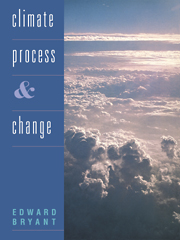3 - Scales of heat and mass transfers in the atmosphere
Published online by Cambridge University Press: 05 June 2012
Summary
BASIC TRANSFERS
(Griffiths, 1976; Harrison et al, 1993)
The transfer of energy to maintain thermal equilibrium over the globe is carried out by four different types of fluxes in the oceans and the atmosphere: sensible heat in air, latent heat, ocean currents and ice. In the atmosphere, energy can be transported by the movement of sensible heat contained in air masses or by latent heat that is locked up in evaporated moisture. In the oceans, the thermal capacity of water is much higher than in the atmosphere, and heat can be transferred by ocean currents. In addition, ice drifting from the poles uses up latent heat of fusion in the process of melting. One gram of ice requires 334.72 joules of heat at 0°C to melt. The magnitude of the first three fluxes are presented in Figure 3.1. The flux for ice melting is uncertain but it is small compared to the other three parameters and can be ignored. The total energy transport zonally across the globe is based upon measurement techniques. Variability in this latter value is due to year-to-year fluctuations between 1974 and 1986, and to different satellites. Energy transport is maximum at 35° N and 40° S, the same points in Figure 2.12 where incoming solar radiation balanced outgoing longwave radiation. While the net energy transfer in each hemisphere must be towards the poles, individual components can vary.
- Type
- Chapter
- Information
- Climate Process and Change , pp. 33 - 57Publisher: Cambridge University PressPrint publication year: 1997



